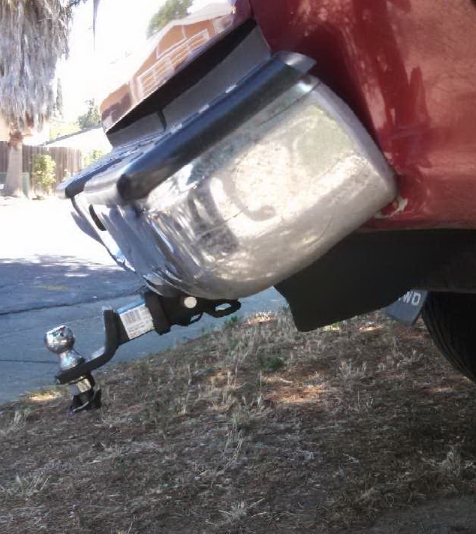A small black sedan struck the rear of the insured’s Toyota pickup and then fled the scene. The insured driver was accompanied by a passenger in the pickup truck at the time of the accident.
GEI was assigned to determine if the evidence supported the allegation of a phantom hit-and-run vehicle striking the rear of the Toyota and to determine the potential for injuries to the occupants of the Toyota from the reported collision.
The rear bumper of the Toyota was permanently deformed from twisting downwards, which forced the ends of the rear bumper into the rear of each rear quarter panel.
This induced minor damage to both rear quarter panels as shown above. The rear bumper support member was also twisted.
There was no damage to the rear tailgate and no evidence of crush damage from an impact force being applied to the rear of the Toyota.
The Toyota was equipped with a trailer hitch assembly that was attached to the rear bumper support member and bolted to the step of the rear chrome bumper. Compared to an aftermarket frame-mounted trailer hitch assembly, this was a weak towing device, which was not designed to carry a heavy load.
The expert examined several very clear photographs of the Toyota damages and of the auto shop repair estimates provided by the client.
Based upon that review, he concluded that the damage to the rear of the Toyota was not consistent with an impact to the rear from another vehicle. There was no evidence of impact damage such as paint or rubber transfers or crush damage to the rear of the Toyota. The damage to the Toyota was produced by placing a heavy load (such as a heavily loaded trailer) on the towing ball of the Toyota. If a trailer was heavily loaded to the front, then the weight of the trailer tongue would be too great for the weak towing device to support, and the result would be a downward pushing torque force onto the trailer ball, which would cause the bumper support bar to twist and fail.
Injuries to occupants occur as a result of a sudden and significant speed change (Delta V) to the vehicle the occupants are riding in. There was no evidence that the Toyota pickup experienced an impact from another vehicle, thus there was no potential for injury to any of the occupants in the Toyota. The torque force that produced the damage to the rear bumper of the Toyota would not produce a speed change to the Toyota.
The client was pleased that they received an expert opinion that helped them to properly adjust the claim.




